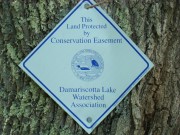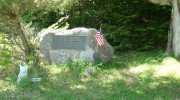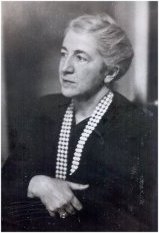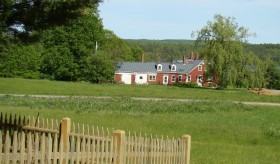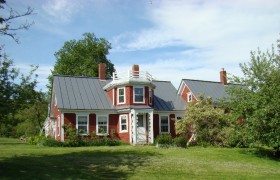Selected works . . .
Cricket and the Emperor’s Son (1962)
The Giant Golden Book of Dogs, Cats, and Horses: 61 stories and poems. (1957)
The House of the Swan (1959)
Knock at the Door (1931)
The Trunk (1941)
The plaque on the stone reads:
HENRY BESTON
JUNE 1 1888 – APRIL 15, 1968
Creation is still going on the creative forces are as great and as active to-day as they have ever been and to-morrow’s morning will be as heroic as any of the world THE OUTERMOST HOUSE
(1893-1986) was a Maine writer of children’s stories, born on May 31, 1893 in Buffalo, New York. She received a B.A. in 1915 from Vassar College and an M.A. in 1916 from Columbia University. She also attended Radcliffe College and received an honorary degree from the University of Maine (1955). [photo courtesy Maine Women Writers Collection, University of New England]
She authored more than one hundred books. While it is the stories she wrote for children that have gathered the most attention and are best remembered today, she also wrote adult fiction and poetry, as well as memoirs. There is a common thread running through all of Coatsworth’s writing though, and that is the reverence she had for her home state of Maine.
A shy girl, she began writing stories and poetry for fun when she was in school. Coatsworth spent much of her life traveling. As a young girl, she and her family visited the Alps, rode donkeys across the deserts of Egypt, explored pre-Revolutionary Mexico on horseback, fished in Catalina, and climbed trails in the Yosemite Valley. After earning her master’s degree, Coatsworth traveled for thirteen months in the Far East.
She began writing poetry in the summer of 1914 while visiting her mother and sister in London. In 1927 her first book of children’s poetry The Cat and the Captain was published by Louise Seaman at Macmillan, who had started the first children’s book department in the United States.
As a young adult, she landed in Massachusetts where she met the man who would become her husband, fellow writer, Henry Beston. Today, Beston is better known than his wife; however, that is not because he was a better writer. Rather it is because his first and best known book, The Outermost House (chronicling a year spent on Cape Cod in a house at the edge of the ocean, communing with nature) has become much appreciated and often quoted by modern environmental and animal rights activists.
During their early days together, Elizabeth spent time with Henry at that house on the Cape, but repetitive storm damage eventually led them to move away from the beach to a suburban neighborhood further inland in Massachusetts. It did not take long, however, for them to realize that they shared a dislike for suburbia. Eventually, Henry happened to come to Maine to visit a friend who lived on Damariscotta Lake. One day during that trip while on the lake in a boat with his friend, Henry spotted the Nobleboro property that he would fall in love with. He soon convinced Kate that they should purchase it and resettle there. They did so in 1931, located on the East Neck Road, and they called it Chimney Farm. The name remains the same today. Elizabeth and Henry would each do almost all of the rest of their writing at the farm, and it was also where they raised their two daughters, Margaret and Katharine.
Coatsworth first achieved acclaim as a poet and short story writer, then turned to children’s books and later to novels and essays. A prolific writer whose publications spanned more than fifty years, she produced over ninety books of fiction and poetry for children. She also wrote numerous adult novels, books of verse, and works about Maine, and edited a volume of her husband’s writings.
Why were Coatsworth’s poems good enough to be published by The New Yorker, yet are little known today? The best answer is that her works suffered from being labeled “regional” in times when regionalism in literature has been out of vogue. Other than the state of Maine, Coatsworth’s writing is characterized by several common threads. First, it often contains a psychological component, or so-called “dark” undercurrent. Second, it deals openly, straightforwardly, and sympathetically with the struggles and strengths of women. Lastly, like her husband, her writing often contemplates humanity’s fractured relationship with the natural world.
ON A NIGHT OF SNOW
Cat, if you go outdoors, you must walk in the snow,
You will come back with little white shoes on your feet,
little white shoes of snow that have heels of sleet.
Stay by the fire, my Cat. Lie still, do not go.
See how the flames are leaping and hissing low,
I will bring you a saucer of milk like a marguerite,
so white and so smooth, so spherical and so sweet –
stay with me, Cat. Outdoors the wild winds blow.
Outdoors the wild winds blow, Mistress, and dark is the night,
strange voices cry in the trees, intoning strange lore,
and more than cats move, lit by our eyes green light,
on silent feet where the meadow grasses hang hoar –
Mistress, there are portents abroad of magic and might,
and things that are yet to be done. Open the door!
In 1931 Coatsworth received the Newbery Medal for her children’s book, The Cat Who Went to Heaven. Today that book is one of only five of hers that remain in print. The others are: Under the Green Willow (also a children’s book), The Enchanted (a novel), Fox Footprints (a poetry collection) and her memoir, Personal Geography, a collection of poetry and writings.
Elizabeth Coatsworth died in 1986, and was buried next to her husband on their farm in Nobleboro. In recent years, several concerned individuals and organizations have undertaken efforts to preserve Chimney Farm in perpetuity as a National Literary Landmark.
Additional resources
Coatsworth, Elizabeth Jane. Papers 1930-1968. Notebooks, diaries of Elizabeth Coatsworth. Two manuscripts of her husband, Henry Beston. Materials located in Special Collections Department, Raymond H. Fogler Library, University of Maine, Orono.
Eddy, Jacalyn. “Elizabeth Jane Coatsworth” in Notable American Women, A Biographical Dictionary: Completing the Twentieth Century, Susan Ware, ed., Cambridge, MA: Harvard University Press, 2004, pp. 129-130.
McCain Library and Archives, University Libraries, University of Southern Mississippi (http://ocean.st.usm.edu/~dajones/findaids/coatswor.htm).
Maine Speaks: An Anthology of Maine Literature. Brunswick, ME. Maine Writers and Publishers Alliance. 1989.
Stover, Douglas. Eminent Mainers. Gardiner, ME: Tilbury House Publishers,2006.
Thomas, Beth A. “Coatsworth’s ‘regional’ writing ripe for revival.” Maine Times, May 1, 1997.
With substantial material contributed by Hope Cruser, Edgecomb, Maine, 2008.


